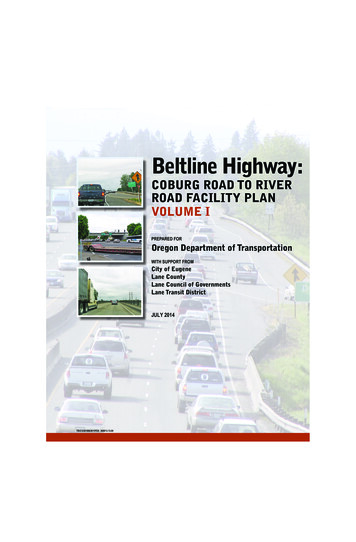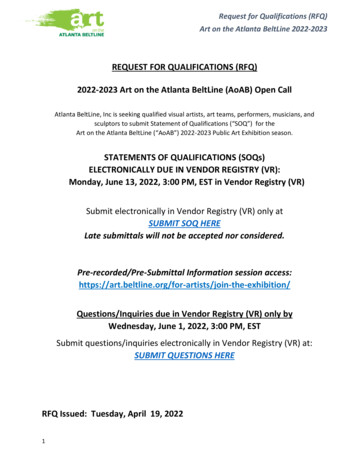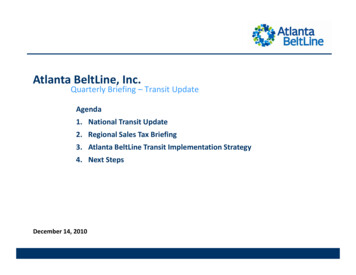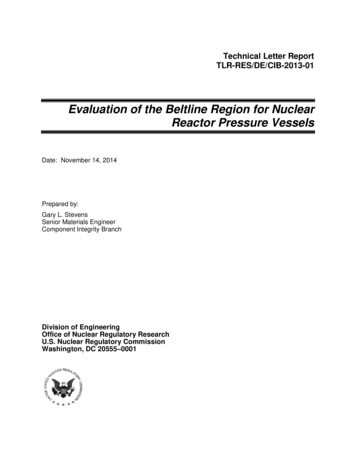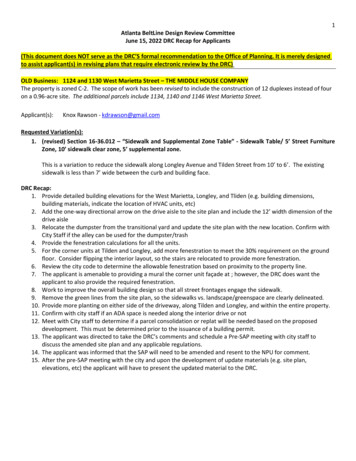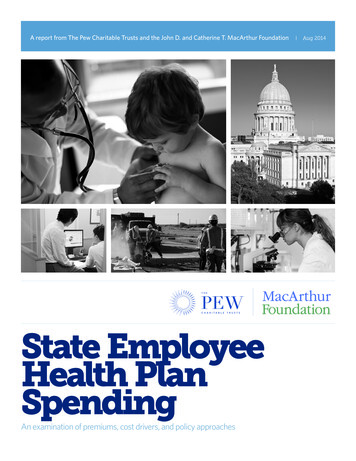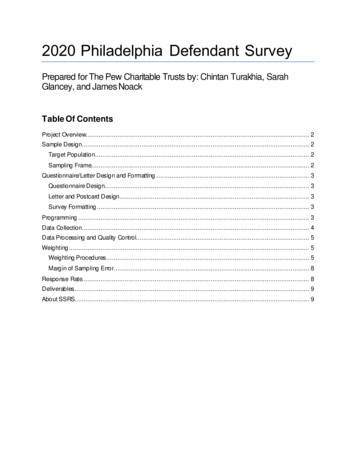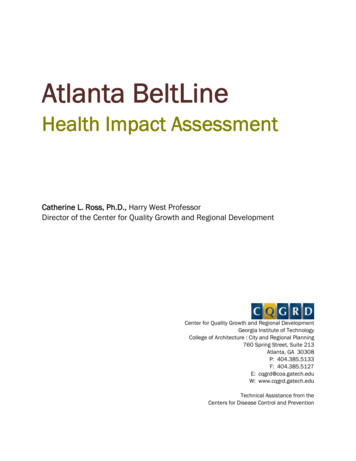
Transcription
Atlanta BeltLineHealth Impact AssessmentCatherine L. Ross, Ph.D., Harry West ProfessorDirector of the Center for Quality Growth and Regional DevelopmentCenter for Quality Growth and Regional DevelopmentGeorgia Institute of TechnologyCollege of Architecture : City and Regional Planning760 Spring Street, Suite 213Atlanta, GA 30308P: 404.385.5133F: 404.385.5127E: cqgrd@coa.gatech.eduW: www.cqgrd.gatech.eduTechnical Assistance from theCenters for Disease Control and PreventionAtlanta BeltLine HIA0
The Atlanta BeltLine Health Impact Assessment, made possible by aresearch grant from the Robert Wood Johnson Foundation, was conductedby the Georgia Institute of Technology’s Center for Quality Growth andRegional Development, with technical assistance from the Centers forDisease Control and Prevention.DISCLAIMER: This report was prepared with technical assistance from theCenters for Disease Control and Prevention (CDC). The contents of thisreport are solely the responsibility of the authors and do not necessarilyrepresent the views or policies of CDC.Principal investigator: Catherine L. Ross, Ph.D., Director of CQGRD and HarryWest ProfessorCore Research Team: Karen Leone de Nie, Research Scientist, GeorgiaInstitute of Technology, Center for Quality Growth and Regional Development(CQGRD); Jason Barringer, Research Scientist, Georgia Institute ofTechnology, CQGRD; Saskia Benjamin, Research Assistant, Georgia Instituteof Technology, CQGRD; Jessica Harbour Doyle, Doctoral Student, GeorgiaInstitute of Technology, CQGRD; Mine Hashas, Ph.D., Post-DoctoralResearcher, Georgia Institute of Technology, CQGRD; Dave Pierce, ResearchAssistant, Georgia Institute of Technology, CQGRDTechnical Assistance Team: Andrew L. Dannenberg, MD, MPH, AssociateDirector for Science, Division of Emergency and Environmental HealthServices, National Center for Environmental Health, Centers for DiseaseControl and Prevention (CDC); Laurie Beck, MPH, Epidemiologist, Division ofUnintentional Injury Prevention, CDC; Susan Hobson, MPH, ORISE Fellow,Division of Emergency and Environmental Health Services, National Centerfor Environmental Health, CDC; Sheryl Lyss, MD, MPH, Fulton CountyDepartment of Health and Wellness; Mary E. O'Neil, MPH, Association ofSchools of Public Health (ASPH) Fellow, Division of Unintentional InjuryPrevention, CDC; Bianca R. Perri, MPH, Public Health Prevention Specialist,CDC; Candace Rutt, Ph.D., Division of Nutrition and Physical Activity NationalCenter for Chronic Disease Prevention and Health Promotion CDC; AprilVance, MPH, Public Health Advisor, Division of Unintentional InjuryPrevention; National Center for Injury Prevention and Control, CDC; and otherCDC staffACKNOWLEDGEMENTS: Numerous people from several organizationsassisted and advised on this project, including Karen Mumford, Ph.D., EmoryUniversity; Wendy Scruggs-Murray, Neighborhood Planning Unit & CitizensParticipation Coordinator, City of Atlanta, and the advisory committee (seeAppendix 1).June 2007Atlanta BeltLine HIA1
ContentsReader’s Guide7Executive Summary9Section 1: Introduction20Section 2: The BeltLine and Health222.1 The BeltLine: Components, History, and Actors222.2 What is health?322.3 How might the BeltLine impact health?332.4 What is a Health Impact Assessment?352.5 Why conduct the BeltLine HIA?36Section 3: BeltLine Health Impact Assessment Methodology383.1 HIA Project Team383.2 Advisory Committee393.3 Screening393.4 Scoping393.4.1 Parameters of the Assessment393.4.2 Affected and Most Vulnerable Populations423.4.3 Identification of key issues483.5 Appraisal of Health Impacts503.6 Next steps50Section 4: Overarching Issues514.1 Timing of the BeltLine514.2 A Well Integrated BeltLine524.3 People-Oriented Priorities574.4 Designing for all Users594.5 Involving all Stakeholders59Atlanta BeltLine HIA2
Section 5: Access and Social Equity615.1 Access, Social Equity, and Health615.2 Access, Social Equity, and the BeltLine625.3 Assessment635.3.1 Parks635.3.2 Trails715.3.3 Transit735.3.4 Housing815.3.5 Food885.4 Recommendations92Section 6: Physical Activity956.1 Physical Activity and Health956.2 Physical Activity and the BeltLine996.2.1 Parks996.2.2 Trails1026.2.3 Transit1046.2.4 Urban Form1066.3 RecommendationsSection 7: Safety1091117.1 Injury and Health1117.2 Injury and the BeltLine1157.3 Crime and Health1177.4 Crime and the BeltLine1187.5 Recommendations124Section 8: Social Capital1268.1 Social Capital and Health1268.2 Social Capital and the BeltLine1298.3 Recommendations129Atlanta BeltLine HIA3
Section 9: Environment9.1 Air Quality1311319.1.1 Air Quality and Health1319.1.2 Air Quality and the BeltLine1329.1.3 Assessment1339.1.4 Recommendations1419.2 Water Resources1419.2.1 Water Resources and Health1429.2.2 Water Resources and the BeltLine1429.2.3 Recommendations1439.3 Noise and Vibration1439.3.1 Noise and Health1449.3.2 Noise and the BeltLine1459.3.3 Recommendations1499.4 Brownfields9.4.1. Recommendations150152Section 10 Summary of Recommendations: an impact management plan153Section 11 Conclusions175References179Appendices199A1: BeltLine HIA Advisory Committee199A2: Content Analysis of Meeting Minutes and Newspaper Coverage201A3: BeltLine Public Involvement and Education Strategy211A4: BeltLine HIA Survey Instrument and Results212A5: Universal Design Principles222Atlanta BeltLine HIA4
List of FiguresFigure 2.1 Existing and Proposed Parks and Trails in the City of AtlantaFigure 2.2 Existing MARTA Rail Service and Proposed BeltLine AlignmentFigure 2.3 Housing Unit Density, 2000Figure 2.4 Housing Unit Density, 2030Figure 2.5 Employment Density, 2000Figure 2.6 Employment Density, 2030Figure 2.7 BeltLine TAD and Primary Redevelopment AreasFigure 2.8 BeltLine TimelineFigure 2.9 Atlanta BeltLine Organizational ChartFigure 2.10 Determinants of HealthFigure 2.11 Steps in the HIA ProcessFigure 3.1 BeltLine HIA Study Area and Planning Area BoundariesFigure 3.2 Census Tracts with Most Vulnerable PopulationsFigure 3.3 Logic Model FrameworkFigure 4.1 A permeable space: conceptualization of flows between components of the BeltLineFigure 4.2 Transit systems in Portland, Oregon and Seattle, WashingtonFigure 4.3 Accessible public restrooms with call boxes and maps are needed along the trails.Figure 4.4 Using the BeltLine to create a web of connectivity throughout the cityFigure 4.5 Public Schools with 0.5 miles of BeltLine Transit and TrailsFigure 4.6 Block and parcel arrangement along BeltLineFigure 4.7 Subdivision of blocks and lots to knit into the existing fabric and create a walkable neighborhoodFigure 5.1 Public Schools near BeltLineFigure 5.2 Health Care Facilities near BeltLineFigure 5.3. Age composition by planning areaFigure 5.4 Park Access in the Study AreaFigure 5.5 Areas with BeltLine Trail AccessFigure 5.6 Areas that have Access to the BeltLine Transit systemFigure 5.7 Census Block Group by Percentage of Rental Housing UnitsFigure 5.8 Average Median Household Income in Relation to AMIFigure 5.9 Average Household Size by Block GroupFigure 5.10 Access to Chain Grocery Stores in the Study AreaFigure 5.11 Proposed Land Use Plan for the Southeast Planning Areas of the BeltLine TADFigure 9.1 2005 High Volume Road SegmentsFigure 9.2 2030 High Volume Road Segments with the BeltLineFigure 9.3 2030 High Volume Road Segments without the BeltLineFigure 9.4 Proposed Land Use around Inman and Tilford Rail YardsFigure 9.5 Proposed Land Use around Hulsey Rail YardFigure 9.6 Proposed Land Uses around High Volume Road SegmentsFigure 9.7 Potential Brownfields with BuffersFigure A1. Examples of buildings with inaccessible and accessible entrancesFigure A2. Inclusive playgrounds with accessible and reachable designFigure A3. The use of raised tactile surfaces at the BeltLine transit stationsFigure A4. Seating features to accommodate special needs and be inclusive for all ability levelsFigure A5. Wide paths or sidewalks with adequate use for everyoneAtlanta BeltLine HIA5
List of TablesTable 2.1 Population and Housing Growth in Atlanta and the BeltLineTable 3.1 Study Area Land Use CharacteristicsTable 3.2. City of Atlanta and Study Area Population ProfileTable 3.3 Population Profile by BeltLine Planning AreasTable 3.4 Crude Death Rate (per 100,000 Population) from Selected Causes of DeathTable 3.5 Crude Death Rate (per 100,000 Population) from Selected Causes of Death, Subareas of theBeltLine Study Area, 2000–04Table 3.6 Proportion of Population Reporting Selected Health Characteristics, Georgia Behavioral RiskFactor Surveillance System, 2000–05Table 5.1 Existing and BeltLine Park Acres/1,000 People (2000 population)Table 5.2. Combined Park Acres/1,000 People (2000 population)Table 5.3 Combined Park Acres/1,000 People (2030 projected population)Table 5.4 Comparing Atlanta to other Major CitiesTable 5.5 Citywide Park Access before and after the BeltLineTable 5.6 Study Area Park Access Before and After BeltLineTable 5.7 Demographic Profile of Potential Users at BeltLine ParksTable 5.8 Access to BeltLine Trail System as Compared to City and Study AreaTable 5.9 Access to Trail System by BeltLine Planning AreaTable 5.10 Access Population Profile for BeltLine Transit as Compared to the City and Study AreaTable 5.11 Demographic Profile of BeltLine Transit Stop Access Population by Planning AreaTable 5.12 Population Growth in BeltLine Transit Access Areas by Planning AreaTable 5.13 Demographic Profile of BeltLine Transit Stop Access PopulationTable 5.14 Estimated Population and Employment Growth of BeltLine Transit Stop Access AreasTable 5.15 Distribution of Rental Units among the BeltLine Planning AreasTable 5.16 Chain Grocery Store Access within the BeltLine Study AreaTable 7.1 Light Rail Collision Fatal and Nonfatal Annualized Injuries and Rates, US, 1999-2003Table 7.2 Property and Violent Crime Rates for Cities of 300,000 to 500,000 population in 2005Table 7.3 Principles of Crime Prevention Through Environmental DesignTable 7.4 Personal Crimes at MARTA Train Stations, 2002-2006Table 7.5 Rates per 100,000 Population of Reported Violent Crimes in the US and Along Selected Rails-toTrails, 1995Table 7.6 Percentages of Selected Rails-to-Trails Reporting DamageTable 9.1 Daily emissions for the Atlanta Region, 2030Table 9.2 Potential New Living Units within 200m Buffer, 2030Table 9.3 Sources of Transit NoiseTable 9.4 Profile of Population Living Near Brownfield Sites in the BeltLine Study AreaAtlanta BeltLine HIA6
Reader’s GuideThe Atlanta BeltLine Health Impact Assessment report provides a summary of more than one year of researchand analysis on the potential health impacts of the Atlanta BeltLine, a project that will dramatically reshape theCity of Atlanta with parks and trails, new transit infrastructure, and significant redevelopment.This report begins by introducing readers to the BeltLine and the ways in which built environment projects, likethe BeltLine, can impact public health. Section 3 describes the methodology that was applied to conduct theHIA and identifies the study area and characteristics of the affected population. Section 4 explores severaloverarching BeltLine issues that can result in various health impacts. These issues tend to influence manydeterminants of health, and therefore are considered more broadly in the HIA. Sections 5 through 9 summarizethe evidence and analysis to identify ways in which the BeltLine may affect access and social equity, physicalactivity, safety, social capital, and environmental factors that influence health. This research focuses onspecific health issues, as well as examines the distribution of BeltLine benefits and disbenefits to variouspopulation groups, either distinguished by socioeconomic group or geographic location. Each sectionconcludes with several recommendations that are intended to expand positive health impacts and remove ormitigate negative health impacts. Section 10 summarized the key findings from the literature review andanalysis, identifies affected populations, lists the recommendations, and identifies how each recommendationimpacts the various categories of health determinants that are the focus of Sections 5 through 9. The reportconcludes with Section 11, which provides an overview of the broadly defined impacts of the BeltLine anddescribes the lessons the project team learned during the course of the HIA.Throughout this report readers will see terminology and references to various geographic areas that may beunfamiliar. Following are brief definitions of these terms and areas.BeltLine Study Area: For the purpose of the BeltLine HIA, the research team selected the TADwith a 0.5 mile buffer on both sides as the BeltLine Study Area. This buffer was selectedbecause it represents the outer range of the generally accepted distance people are generallywilling to walk to access transit or parks and is supported by the results of a local study ofpark users, which analyzed the distance people walk to get to parks. The Study Arearepresents approximately 30,500 acres (see Figure 3.1, page 39).BeltLine Planning Areas: The City of Atlanta has identified the TAD and the surrounding areasas the BeltLine Planning Area. They have also divided the loop into five segments, theNorthside, Northeast, Southeast, Southwest, and Westside (see Figure 3.1, page 39).Tax Allocation District: The Tax Allocation District (TAD) boundaries have been adopted bylocal elected officials as the areas were incremental increases in tax revenues due toincreases in property values can be collected to invest in improvements in said area. SeeFigure 2.7 (page 25) for the boundaries of the BeltLine TAD, which represents 6,545 acres ofthe City of Atlanta.Health: For the purpose of the BeltLine HIA, health has been defined as “a state of completephysical, social and mental well-being, and not merely the absence of disease or infirmity”and ability of an individual or group “to identify and to realize aspirations, to satisfy needs,and to change or cope with the environment.”Atlanta BeltLine HIA7
Health Impact Assessment: A Health Impact Assessment (HIA) is “a combination ofprocedures, methods, and tools by which a policy, program, or project may be judged as to itspotential effects on the health of a population, and the distribution of those effects within thepopulation” (WHO, Gothenburg Consensus, 1999). HIAs explicitly consider social andenvironmental justice issues, adopt a multidisciplinary and participatory process, and useboth qualitative and quantitative evidence as well as transparency in the process.Readers may find it useful to understand the numerous actors that play a role in the development of theBeltLine. A list, with descriptions, is available on page 29.Atlanta BeltLine HIA8
Executive SummaryThe Atlanta BeltLine project is one of the largest redevelopment projects currently underway in the UnitedStates. It includes the transformation of a 22-mile loop of freight rail to parks, trails, transit, and residential andcommercial developments. It leverages public funds to attract private investment in the redevelopment of thiscorridor encircling the city's core. The project has been viewed as a springboard for a new vision for the City ofAtlanta, one of greenspace, walkability, high-quality infill development, transit, and healthy communities.With funding from the Robert Wood Johnson Foundation, Georgia Tech’s Center for Quality Growth andRegional Development (CQGRD), with technical assistance from the Centers for Disease Control andPrevention (CDC), began an Health Impact Assessment (HIA) of the BeltLine in 2005. The goal of the BeltLineHIA is to make health a part of the decision-making process related to the BeltLine by predicting healthconsequences, informing decision makers and the public about health impacts, and providing realisticrecommendations to prevent or mitigate negative health outcomes. To undertake this task, the HIA teamincluded researchers and practitioners with expertise in public health, city planning, and transportationplanning. This report contains numerous recommendations concerning public policy, implementation, design,maintenance, and operations of the BeltLine. These recommendations are intended to give decision makers,community members, designers, and project implementers strategies that can be utilized to support positivehealth outcomes for all of the populations affected by the BeltLine.While the assessment is limited to the BeltLine and its immediate surroundings, many of the findings andrecommendations are relevant to the City of Atlanta and the larger Atlanta metropolitan region. HIAs enablecommunities to make the goal of positive health outcomes for all people a primary element in deciding thecourse of future project and policies.The BeltLine VisionThe Atlanta BeltLine is a transit, trails, parks, and redevelopment project that uses a 22-mile loop of largelyabandoned freight rail line that lies between two and four miles from the city center. It will affect approximately45 neighborhoods, touching all council districts in the City of Atlanta. The BeltLine will result in improvementsto 700 acres of existing parks and the addition of 1,300 acres of new greenspace and parks. The BeltLinevision includes 33 miles of new multi-use trails connecting 40 parks and a 22-mile loop of rail transit service,with an anticipated daily ridership of over 73,000.The 6,545 acres of redevelopment (approximately seven percent of the city’s land area) will create over29,000 housing units, of which approximately 5,600 units will be set aside for lower-income individuals andfamilies; 30,000 new jobs; and almost 12 million square feet of new construction, to include 5.3 million squarefeet of office space, over 1.3 million square feet of retail space; 5.2 million square feet of industrial; and407,000 square feet of public or private institutional space. In addition, there will be sidewalk, streetscape,road, and intersection improvements planned throughout the BeltLine area to link the parks, trails, transit, andredevelopment of the BeltLine to existing neighborhoods. Taken together, the BeltLine components areintended to create a continuous loop of urban regeneration around the core of the city. Linked by transit andgreenspace, the BeltLine will connect people with places and with each other.Atlanta BeltLine HIA9
The BeltLine vision is made possible by a funding strategy called a Tax Allocation District (TAD) 1, whichrequired the approval of the City of Atlanta, Fulton County, and the Atlanta Public Schools. The TAD, a clearlydefined area of the City of Atlanta, uses the incremental increase in taxes due to increased property values inthe district to repay TAD bonds used to fund capital improvements for the BeltLine. The TAD is expected toraise approximately 1.7 billion over a 25-year period; therefore, the publicly funded improvements, like parkdevelopment, new infrastructure, brownfield cleanup, and workforce housing, will take place over time.Ultimately, the BeltLine is expected to result in an approximately 20 billion increase in the tax base over 25years.Health and the Built EnvironmentThe World Health Organization defines health as “a state of complete physical, social and mental well-being,and not merely the absence of disease or infirmity.” The 1986 Ottawa Charter for Health Promotion expandsthis definition to include the ability of an individual or group “to identify and to realize aspirations, to satisfyneeds, and to change or cope with the environment.” These definitions are important in their recognition thatnumerous causes influence the ability to be healthy. Known as health determinants, these factors includebiological, social and economic, environmental, lifestyle, services, and policy. Many external factors—theenvironment where we live, work, and go to school; and the social and economic factors, policies, and servicesthat shape the environment—affect the ability to be healthy. It is these health determinants which the BeltLinehas the greatest ability to shape through specific policies and interventions.To reflect on the role the BeltLine can play in health, it is necessary to explore the relationship between the builtenvironment and health. The built environment is the manmade surroundings that provide the setting for humanactivity. It is composed of land use patterns, transportation systems, and urban design. Land use patternsestablish the proximity of different activity centers and spatially determine where we do things—work, school,shop, and other activities. Transportation connects the activities that have been organized into the land usepatterns; the transportation system informs the options people have for getting to these different places. Urbandesign is reflected in the land use patterns and the transportation infrastructure. Design determines how far abuilding is from the street, the width of a sidewalk, and the placement of street trees and benches. Designinstructs the character of the buildings and sets the overall aesthetic qualities of the constructed environment.In recent years research has suggested a linkage between the characteristics of the built environment andhuman health outcomes, such as respiratory and cardiovascular health, fatal and non-fatal injuries, physicalfitness, obesity, mental health, and social capital. Although causality is not conclusively proven, there issufficient evidence linking elements of the built environment and health to warrant inclusion of healthconsiderations in project and policy decisions. As such, there is reason to believe that the BeltLine, which willdirectly affect over 6,500 acres of the city, will play a role in the future health of the people who live, work, play,and go to school near it. A well-designed BeltLine project can encourage healthy behaviors by providing peoplewith the infrastructure and urban design to encourage walking, biking, and transit as viable transportationoptions; by providing parks and trails for physical activity and social interaction; and by locating jobs andservices, such as grocery stores and health care centers, closer to where people live. Furthermore, the lessonslearned in the development of the BeltLine can inform new development and redevelopment throughout thecity and region.A Health Impact AssessmentAn Health Impact Assessment (HIA) is “a combination of procedures, methods, and tools by which a policy,program, or project may be judged as to its potential effects on the health of a population, and the1Atlanta’s Tax Allocation Districts operate on the same principles as tax increment financing.Atlanta BeltLine HIA10
distribution of those effects within the population.” Four values are integral to the HIA: democracy, equity,sustainable development, and the ethical use of evidence that emphasizes a rigorous structured analysisbased on scientific disciplines and methodologies. HIAs explicitly consider social and environmental justiceissues, adopt a multidisciplinary and participatory process, and use both qualitative and quantitativeevidence as well as transparency in the process. An HIA is intended to make health considerations part ofthe decision-making process. Furthermore, HIAs seek to link these impacts to a given segment of thepopulation (for example, children, older adults, people living in poverty, or residents of a particularneighborhood). The final product of an HIA is a set of evidence-based recommendations intended to informdecision-makers and the general public about the health-related issues associated with the project. Therecommendations provide practical solutions that seek to magnify positive health outcomes and minimizenegative impacts.The steps of an HIA include: screening, which determines whether or not there exists the potential forsignificant health impacts as the result of a policy, program, or project; scoping, which establishes the studyarea boundaries, identifies possible consequences, and determines a management approach for the HIA;appraisal, which considers the nature and magnitude of health impacts and the affected populations;dissemination, which circulates the results of the HIA to decision makers, individuals implementing theplan/policy, and community stakeholders; and monitoring and evaluation, which reviews the effectivenessof the HIA process and evaluates the actual health outcomes as a result of the project or policy.Potential Health Impacts of the BeltLineThe BeltLine HIA resulted in the identification of several critical overarching issues and five primary areas ofpotential health impacts related to the BeltLine, including access to health promoting amenities and goods,opportunities for physical activity, safety, social capital, and environmental issues like air quality, waterresources, noise, and brownfields. The key findings are summarized below. 2Overarching IssuesThere are several issues related to the BeltLine that are not limited to specific health impacts, but are moregenerally related to overall quality of life issues or numerous health concerns. These include the timing of theBeltLine, integration of the BeltLine, mobility priorities, designing for all users, and involving all stakeholders inthe decision-making process.Timing of the BeltLine: The BeltLine faces the challenge of implementing a unifying revitalization andredevelopment plan, but with a combination of public- and private-sector investment. The difficultyarises because private entities operate within a much different process and timeframe than publicentities. The result of the differences in public and private progress is a temporal mismatch, where thepublicly funded parks and transportation improvements necessary to make the new development livablefor both new and existing residents and businesses lag behind private development. While some delay isinevitable, too great a disparity between the work of the two sectors can have health and more broadlyquality of life implications.A Well Integrated BeltLine: The rail corridor that will become the multi use BeltLine has historicallydivided people and places. The new vision for this corridor has the opportunity to reintegrate manyneighborhoods. If such an environment is created several health benefits can be realized, includingincreases in physical activity, improved social capital, and improved access to health promoting goods,services, and amenities. A well integrated BeltLine means two things: (1) its components—trails andparks, transit, and redevelopment—work well together, and (2) the entirety of the BeltLine becomeswoven into the fabric of the city and region.2Please refer to the complete report for references and evidence of specific health impacts.Atlanta BeltLine HIA11
People-oriented Priorities: Three of the fundamental components of the BeltLine—transit, trails, andredevelopment—are intended to emphasize the mobility of people, not automobiles. This peopleorientation means that streets are no longer simply conveyors of automobiles, but must serve the needsof multiple modes of travel becoming “complete streets.” A complete street is one that works formotorists, transit riders, bicyclists, and pedestrians, including people with disabilities.Designing for all Users: BeltLine users will represent a diverse population that will vary in age, income,culture, and ability. Users will include older adults, children, people with disabilities, non-Englishspeakers, and others whose mobility can be affected by short- or long-term limitation in ability. Inparticular, the population aged 65 and older is expected to increase dramatically in the next 20 years.Considering the fact that almost 80 percent of people over age 65 have at least one chronic healthcondition, and 50 percent have at least two chronic health conditions, which often lead to disability, thenumber of people living with functional limitations and disabilities will also increase.Involving all Stakeholders: Within the BeltLine HIA Study Area there are more than 200,000 residents,230,000 employees, and numerous businesses and institutions that will be directly affected by theBeltLine, and there will be additional people living and working in the study area as the project progresses.The larger city and region will also be affected by the BeltLine’s influence over regional traffic patterns andenvironmental impacts. Combined, these stakeholders represent a diversity of interests, preferences, andneeds. To reflect the uniqueness of the population and the project, three principles regarding theinvolvement of all stakeholders are important to the implementation of the BeltLine: continuous publicinvolvement, appropriate public involvement, and convenient access to information.Access and Social EquityAccessibility is a crucial element for achieving a healthy city. Access refers to an individual’s or group’s abilityto get to health-promoting places, goods, services, and amenities, with reasonable ease, cost, and time. It isconcerned with proximity as well as the infrastructure that enables people to travel to these destinations.Numerous studies have linked several critical needs to support good health including transportation,greenspace, housing, and food. Specific health conditions associated with access or the lack of access includeobesity, diabetes, heart disease, mental and social health, and poor physical condition.For decades the largely underutilized rail corridor circling the City of Atlanta, created a divide that severedcommunities from goods, services, and opportunities. The BeltLine, as a new vision for this corridor, is in largepart an accessibility enhancing project intended to link destinations and people either by putting places andpeople in closer proximity through redevelopment of underutilized land or by providing a more variedtransportation system.The BeltLine HIA evaluates the degree to which access to parks, trails, transit, and redevelopment meet theneeds of the existing and future populat
Atlanta BeltLine HIA 4 Section 9: Environment 131 9.1 Air Quality 131 9.1.1 Air Quality and Health 131 9.1.2 Air Quality and the BeltLine 132
